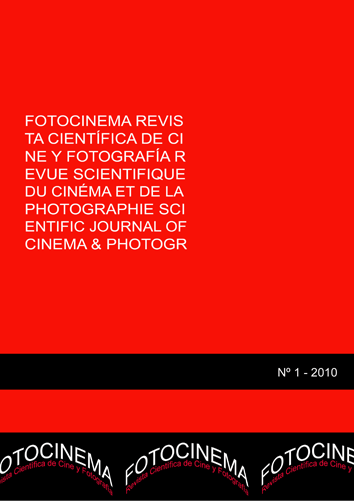Polinización transtextual en La edad de la inocencia (1993)
DOI:
https://doi.org/10.24310/Fotocinema.2010.v0i1.5853Abstract
La historia del cine es ciertamente atractiva si se estudia de manera transversal, teniendo en cuenta para ello las distintas manifestaciones artísticas que concurren en una misma o distinta época y que comparten rasgos formales que las vinculen. Tomando el filme La edad de la inocencia (1993) como caso de estudio, diversas relaciones transtextuales, entre las cuales, la hipertextualidad, la intertextualidad y la metatextualidad, afloran entre disciplinas como la literatura, el teatro, la pintura y la fotografía; todas ellas presentes en la película e imbricadas en un discurso que concierne a las formas de representación de la realidad. Y es precisamente a través de la interrelación del cine con las demás artes donde tiene lugar la Inter.-discursividad, como si el cine, a su paso, polinizase varias texturas de diversa naturaleza, dejando en ellas el trazo cinematográfico de su autor.
Palabras clave: cine; transtextualidad; interdiscursivida.
Key words: film; transtextuality; interdiscursivit.
Downloads
Metrics
Downloads
Published
How to Cite
Issue
Section
License
All contents published in Fotocinema Revista científica de cine y fotografía are protected under the Creative Commons Attribution-NonCommercial-ShareAlike 4.0 International (CC BY-NC-SA 4.0) license. All about this license is available in the following link: <http://creativecommons.org/licenses/by-nc-sa/4.0>
Users can copy, use, redistribute, share and exhibit publicly as long as:
- The original source and authorship of the material are cited (Journal, Publisher and URL of the work).
- It is not used for comercial purposes.
- The existence of the license and its especifications are mentioned.
There are two sets of authors’ rights: moral and property rights. Moral rights are perpetual prerogatives, unrenounceable, not-transferable, unalienable, imprescriptible and inembargable. According to authors’ rights legislation, Fotocinema. Revista científica de cine y fotografía recognizes and respects authors moral rights, as well as the ownership of property rights, which will be transferred to University of Malaga in open access. The property rights are referred to the benefits that are gained by the use or the dissemination of works. Fotocinema. Revista científica de cine y fotografía is published in an open access form and it is exclusively licenced by any means for doing or authorising distribution, dissemination, reproduction, , adaptation, translation or arrangement of works.
Authors are responsable for obtaining the necessary permission to use copyrighted images.













13.png)



